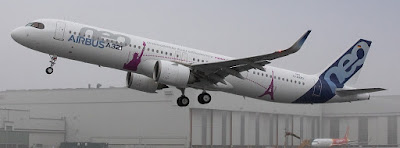Even though Boeing has been hard hit by the grounding of the 737 MAX caused by the two tragic incidents, worsely compounded by the chinese virus pandemic, Boeing still has to move forward with its Airliner Development.
 |
| Boeing 737 MAX9 |
As Boeing itself has identified, it has an airliner model gap between the 737 model line, and the 787 and 767 model lines. This has been caused by the absence of a replacement for its 757 line, of which the replacement cycle for it has began. The 757 has been mostly replaced by the Airbus A321LR, and soon by the A321XLR.
 |
| Airbus A321LR |
Boeing also has no replacement in the area formerly occupied by the former MD95 that was renamed the Boeing 717, after the merger with McDonnell Douglas aircraft company. This area is now occupied by the Bombardier designed and built CS100 and CS300, that was sold to Airbus for $1 and became the Airbus A220.
 |
Bombardier CSeries, now called Airbus A220 |
Had the Boeing - Embraer merger proceeded, without the MAX and chinese
virus
pandemic fiascos, the new Embraer E2 195 line could have competed with
the A220 in this sector. This sector was also covered in the past by the
earliest 737 versions before the 737 was made bigger at least twice.
The 737 MAX7 still covers part of this sector but will not be as
competitive versus the newer Bombardier designed and originally built CSeries.
 |
| Embraer E2 195 |
Thus Boeing has two product line gaps to plug, the 757 replacement and the 717 replacement. Both the A321LR and the A220 lines has effectively reduced market shares in these areas.
In my previous blog Boeing 737-11 NEW, Or Boeing 717 - The 757 Replacement I discussed a possible 757 replacement concept founded on the 737 MAX, with a NEW wing, longer fuselage and updated engines.
Prior news items has talked of a possible new engines for the venerable Boeing 767, now solely produced as a Freighter or as a Refueling Tanker. Boeing has a contract for 179 KC-46 Pegasus Tankers with the US Air Force but there is probably low chances of reengining for these since it will muddle the maintenance logistics chain.
 |
| KC-46 Pegasus |
If
Boeing gets enough orders for reengined 767 Freighters, it will most
probably proceed. It may well turn the 767 as the C-47/DC-3 aircraft of
the 21st century that lives on and on. If the economics is right, Boeing
may even offer an airliner version of the 767, that has already a
modernized cockpit based on the 787.
My take on the Possible Boeing Timeline For Airliner Development In 2020 To 2040, from Board decision to first flight
2022-2026 737-11 NEW, to evolve as the Boeing 717 as 757 replacement
2024-2027 Reengined 767-XF
2030-2035 737 Replacement, maybe Truss-Braced Wing with Open Rotor engine
 |
| Boeing Truss-Braced Wing Concept |
717
replacement will depend on Boeing's financial capacity after the MAX
and chinese virus fiascos; or maybe revisit the merger of Boeing and
Embraer. Or adopt the Mitsubishi SpaceJet for this area as Boeing and
Mitsubishi are already partners in the 787.
 |
| Mitsubishi SpaceJet |


































